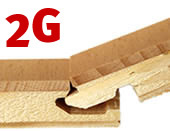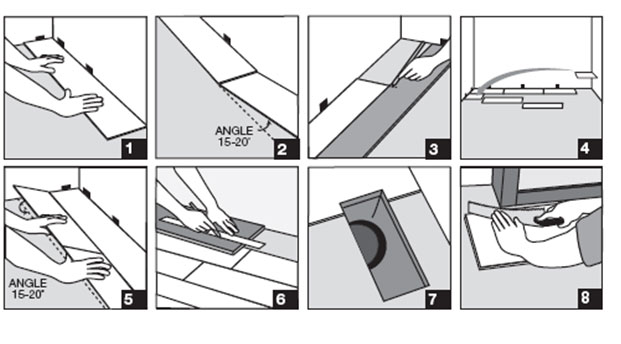>OMI CLICK RESILIENT VINYL PLANK
INSTALLATION GUIDELINES
Installation instance show
Valinge interlocking joints
There are two types of Valinge interlocking joints used in our floors - the 2G and the 5G. Rather than try and explain them, click on either of the two pictures and have a look at the videos which will show you exactly how these two jointing systems work.


Knowing OMI Click Luxury Vinyl:
• OMI features new Click technology, a floating floor system that only requires minimal hand tools. A quiet, fast and clean installation process.
• OMI is intended for interior installations only, suitable for below- grade, on –grade and above-grade installations. OMI should not be installed where the applications substrate is exposed to weather elements.
• As a floating floor, it should be allowed to expand and contract freely. Permanent fixtures must be installed prior to installation of OMI. A minimal 5/16”-3/8” expansion space is required in all areas. If needed, fill the expansion space with a waterproof flexible silicone sealant.
• Areas larger than 25’x30’ require T-molding transitions, as do doorways under 4’ in width.
• OMI must be acclimated for a minimum of 48 hrs., a consistent room temp. of 65-70 degrees, with a relative humidity of 35-55% should be maintained before, during and after all installations.
• Direct exposure to sunlight may cause fading, and or joint separation. OMI is not recommended for installation in sunrooms.
• OMI is water resistant, however, constant/prolonged exposure to excessive moisture/humidity may affect the product. Moisture/humidity issues must be addressed and corrected prior to commencing installation.
PRE-INSTALLATION PROCEDURES
Job Site Evaluation
1.Examine the driveway and landscaping surrounding the building. Be sure that they slope away and direct water away from the foundation.
2.All gutters and downspouts should be in place, directing water away from the building.
3.The building should be closed in with all outside doors and windows in place.
4.All concrete, masonry, framing members, drywall, paint and other "wet" work should be thoroughly dry.
5.The wall coverings should be in place and the painting completed except for the final coat on the base molding. (When possible, delay installation of base molding until flooring installation is complete.)
6.Basements and crawl spaces must be dry and well ventilated. (Crawl space must be a minimum of 24" (600 mm) from the ground to underside of joists. A ground cover of 6-8 mil black polyethylene film is essential as a vapor barrier with joints lapped six inches and taped. The crawl space should have perimeter venting to a minimum of 1.5% of the crawl space square footage. These vents should be properly located to foster cross ventilation).
7.Permanent air conditioning and heating systems should be in place and operational.
8.The installation site should have a consistent room temperature of 60-70 degrees F and humidity of 35-55% for 14 days prior, during and after installation for a proper living environment.
9.HVAC Systems should be in place and working 10 days before installation.
10.Substrates must be checked for moisture content using the appropriate testing methods.
SUITABLE SURFACES
Lightly textured or porous surfaces; well-bonded sheet vinyl, vinyl tile or ceramic tile. Embossed surfaces and or grout lines may telegraph thru, so these must be filled with an appropriate Portland based levelor. Structurally sound solid wood floors, plywood and OSB. Wood substrates should be tested for moisture using an invasive moisture meter, levels must not exceed 14%. Dry, clean well-cured concrete (cured for at least 90 days prior). Test concrete for moisture and PH before installing Accenture.
A calcium Chloride test for moisture should be no more than 8lbs (MVER). PH test for alkalinity should be between 7-9. All surfaces must be clean and dust free. RC Resilient Vinyl may be installed over radiant heated floors (Surface temperature must never exceed or sustain 85ºF).
OMI Resilient Vinyl may be installed on all grade levels including basements. Although OMI is water resistant, moisture issues must be identified and corrected prior to any installation.
UNSUITABLE SURFACES
Damp or wet concrete, rough, uneven surfaces including carpet and any cushioned underlay. Rough, heavy textured and/or uneven surfaces may telegraph through the vinyl and distort the finished surface. This product is not suitable in rooms that could potentially flood or rooms that have damp concrete or saunas. Do not install this product in areas which are exposed to long term direct sunlight and or extreme temperature changes.
“INSTALLATION IMPLIES ACCEPTANCE”
WARNING: DO NOT REMOVE OLD RESILIENT VINYL FLOORING.THESE PRODUCTS MAY CONTAIN EITHER ASBESTOS FIBERS OR CRYSTALLINE SILICA, WHICH CAN BE HARMFUL TO YOUR HEALTH.
PREPARATION
The vinyl planks should be allowed to acclimatize at room temperature approx 65-70ºF for 48 hours prior to installation (Excessive cold or heat can affect the size of individual planks). Must be stored horizontally, flat, no more than 6 cartons high, off the floor to allow for air circulation. Carefully check planks for any defects before installation. Check that all BATCH NUMBERS and ITEM NUMBERS are the same and that you have purchased sufficient material to complete the job. Remove any traces of glue or residue from the previous flooring.
New concrete floors need to dry out for at least 90 days prior to installation. Wood plank floors require a plywood subfloor. All nail heads or fasteners must be driven down below the subfloor surface. Securely fasten all loose subfloors to remove squeaks and or deflection. Scrape, plane or fill uneven boards, holes or cracks using floor-leveling compound if sub-floor is uneven – over 1/8 in (3.2mm) within a span of 4ft (1.2m). If installing over existing tile, use a floor leveling compound to
skim coat grout lines. Make sure the floor is smooth, clean and free of wax, grease, oil or dust and sealed as necessary before laying planks.
TOOLS AND SUPPLIES:
Utility knife, spacers, pencil, tape measure, square, knee pads and safety goggles.
GETTING STARTED:
Determine the direction that the flooring will be installed. Installation parallel to the longest wall is recommended for best visual effects. Undercut all door jambs by turning a plank upside down and using a handsaw to cut away the necessary height so that planks slide easily under the frames. Diagram 8. Remove any existing base, quarter round, shoe molding and door thresholds. Sweep or vac to remove any debris. Floor should be installed from several cartons at the same time to insure a good color and shade mixture. Before starting determine the width of the last row of planks, if less than 2”, trim the width of your starting row of planks. Be attentive to staggering the ends of the vinyl planks a minimum of 16” for a more favorable overall appearance of the floor.
INSTALLATION:
Start in the room’s left hand corner, working toward your right, by placing the first plank with the tongue side facing the wall. Use spacers along each wall to maintain an expansion space of 8-12mm (5/16 in -3/8 in) between the wall and the flooring. Diagram 1. If the wall is irregular you may have to trace and trim the planks.
To attach the second plank, insert the end tongue into the end groove of the very first plank at an angle of approx. 15-20 degrees. When lowered, the plank will click into place. Line up edges carefully. The planks should be flat the floor. Diagram 2.
Continue connecting the first row until you reach the last full plank. Fit the last plank by rotating the plank 180º with the pattern side upward, place beside row. Measure and mark (allowing for spacer), then using a square and utility knife, score the plank and snap it off. Attach as described above. Diagram 3.
Begin the next row with the off cut piece from the previous row to stagger the pattern. Pieces should be a minimum of 20 cm (8 in) long and joint offset should be at least 40 cm (16 in).Diagram 4.
NOTED: It is faster to assemble planks into a new row at the ends and then attach the entire row to the previous row on the long sides.
To start your second row, lay your first planks on the subfloor. Take your second plank, insert the end tongue into the end groove of the first plank at an angle of appro.15-20 degrees. When lowered, the plank will click into place with light pressure. The planks should be flat to the floor. Make sure gaps are as small as possible. Continue assembling the planks this way until you have your second row complete.
To attach the second row to the fist row, tilt and push the side tongue into the side groove of the first panel at an angle of approx.15-20 degrees. Lower and click into place lining the edges up carefully. Continue laying remaining planks in this manner. Diagram 5.
To fit the last row, lay a plank on top of the previous row. With the tongue to the wall, lay another plank upside down on the one to be measured and use it as a ruler. Don’t forget to allow room for spacers. Cut the plank and attach into position. Diagram 6.
Door frames and heating vents also require expansion room. First cut the planks to the correct length. Then place the cut planks next to its actual position and use a square to measure the areas to be cut out and mark them. Cut out the marked points allowing the necessary expansion distance on each side. Diagram 7.
You can trim door frames by turning a plank upside down and using a handsaw to cut away the necessary height so that planks slide easily under the frames. Diagram 8.

Note:
Remember a 5/16-3/8”(8mm-12mm) expansion space is required around all objects.
Completing the job:
Remove all spacers, install baseboards or quarter round to cover expansion joint. Install door transition moldings, (do not nail any moldings or transitions
thru the resilient vinyl flooring). Sweep or vac up any remaining debris. Clean as necessary with a quality resilient vinyl floor cleaner.
To prevent surface damage avoid rolling heavy appliances and furniture directly on the floor, use plywood or hardboard if necessary.
CARE AND MAINTENTANCE
Sweep, dust mop or vac regularly to remove surface grit and dust. Use a damp cloth or mop with a quality resilient vinyl floor cleaner to clean up dirt and footprints, (be careful to avoid using excessive moisture). All spills should be cleaned up immediately.
CAUTION: Planks are slippery when wet.
Do not use a wet spray micro fiber mop. Never use wax, polish, vinegar, abrasive cleaners or scouring agents as they may dull or distort the finish.
High heels can damage floors. Use protective pads under all furniture. Use exterior doormats at all entrance ways to keep dirt and moisture from being tracked in. Avoid use of interior rubber, foam or plastic back mats as they may discolor the floor. To prevent slippage of area rugs use an approved latex rug underlay from a reputable manufacturer. Do not allow pets with unclipped nails to scratch or damage the floor.
Do not use steam cleaners in your care and maintenance.
Avoid exposure to direct sunlight for prolonged periods of time. Use drapes or blinds to minimize direct sunlight during peak sunlight hours.
It’s a good idea to save a few planks in case of accidental damage. Planks can be replaced or repaired by a qualified professional.
WARRANTY
This guarantee is for replacement or refund of the OMI Resilient Vinyl Plank flooring only, no labor (including the cost of labor for installation of the replacement floor) or costs incurred with loss of time, incidental expenses or any other damage. It doesn’t cover damage from improper installation or maintenance, burns, tears, scratches and or indentations of any kind, stains or reduction in gloss level due to normal use and or exterior applications. Any pieces that appear to have defects should not be installed. Accenture will not be responsible for any claim installed with visual defects.
This Limited Warranty is null and void, if prior to installation OMI is not acclimated and if post installation, such acclimation environment is not continuously maintained per written guidelines.
OMI Guidelines/Warranty are revised periodically and floors must be installed according to current guidelines at the time of installation. Please check with your vendor for the current guidelines.
25 Year Limited Residential Warranty
Our 25-Year Residential Limited Warranty for vinyl plank means that for 25 years, from the date of purchase, your floor will be free from manufacturing defects and will not wear through or permanently stain from common household agents when installed and maintained according to instructions supplied with each carton. Improper installation or workmanship should be directed to the contractor who installed the floor.
10 Year Limited Light Commercial Warranty
Our 10 Year Limited Commercial Warranty for vinyl plank means that for 10 years, from the date of purchase your floor will be free from manufacturing defects and will not wear through or permanently stain from common household agents when installed and maintained according to instructions supplied with each carton. Improper installation or workmanship should be directed to the contractor who installed the floor.